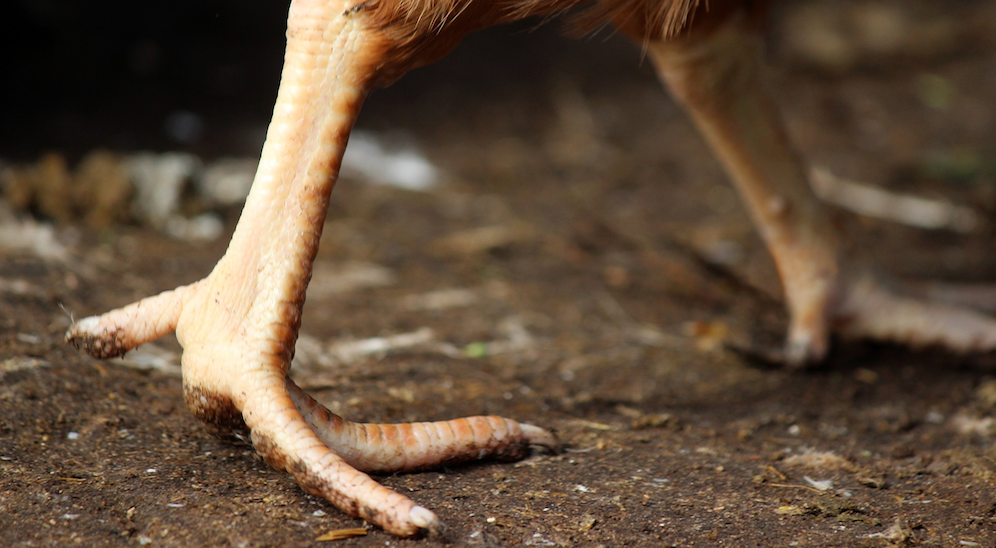Amidst the bustling coop, chickens scratch and forage with unwavering enthusiasm. However, beneath this idyllic scene, a sinister affliction can silently lurk—bumblefoot. This debilitating condition can wreak havoc upon the lives of these cherished creatures, leaving them in agony and distress. Yet, with compassion and understanding, we can empower ourselves with the knowledge to mend their feet and restore their well-being.

Image: grubblyfarms.com
Deciphering Bumblefoot: The Silent Adversary
Bumblefoot, also known as pododermatitis, is a bacterial infection that strikes the feet of chickens, causing inflammation, swelling, and abscess formation. Its insidious nature often goes unnoticed until the condition has progressed considerably, making early detection crucial for preventing severe complications.
The feet of chickens are exceptionally vulnerable due to their constant contact with contaminated environments such as wet or dirty bedding, rough surfaces, or sharp objects. When a wound or puncture occurs, bacteria can penetrate the skin, leading to infection and the development of bumblefoot.
Recognizing the Telltale Signs
Identifying bumblefoot in chickens requires a keen eye and a gentle touch. The initial manifestation may appear as a small, red, and painful swelling on the footpad. As the infection progresses, the swelling worsens, and a core of pus may develop. In severe cases, multiple abscesses can form, leading to lameness, reluctance to move, and a diminished quality of life for the afflicted chicken.
Prompt intervention is paramount to mitigate the severity of bumblefoot and prevent its detrimental consequences. By paying close attention to your chickens and monitoring their behavior and physical condition, you can provide timely assistance and alleviate their suffering.
Navigating Treatment Options
The choice of treatment for bumblefoot depends on the severity of the infection. For mild cases, a combination of antibiotics and topical treatments may suffice. However, surgical intervention may be necessary in more advanced stages, where abscesses have formed or the infection has spread to underlying tissues.
Antibiotic therapy is typically the first line of defense against bumblefoot. Medications such as penicillin or erythromycin can effectively combat the infection and prevent further spread. Topical treatments can provide additional relief, reducing inflammation and pain. Commonly used topical treatments include antiseptic solutions, antibacterial salves, and poultices.
In cases where antibiotic and topical treatments prove ineffective, or the infection has become more severe, surgical intervention may be required. Surgery involves draining the abscess, removing any necrotic tissue, and promoting wound healing. This procedure necessitates veterinary expertise and should only be performed by a qualified professional.

Image: www.dineachook.com.au
Prevention: The Proactive Approach
Preventing bumblefoot requires a holistic approach that encompasses environmental management, proper hygiene, and routine foot care. By maintaining a clean and dry coop, providing perch covers or roosting bars, and ensuring adequate bedding, you can minimize the risk of foot injuries and subsequent infections.
Regularly trimming the chickens’ claws and inspecting their feet for cuts and abrasions are essential preventive measures. Early detection and prompt treatment can effectively halt the progression of bumblefoot and safeguard the well-being of your flock.
How To Fix Bumblefoot On A Chicken
Conclusion: Empowering Chicken Guardians
Bumblefoot in chickens is a complex affliction that requires compassionate care and informed decision-making. By engaging in proactive prevention measures, diligently observing your chickens for early signs of infection, and seeking appropriate treatment when necessary, you can support the health and happiness of these beloved creatures. Remember, with knowledge and empathy, we can become effective guardians and create a nurturing environment where they thrive.
Together, let us embrace the responsibility of ensuring that chickens remain free from the pain and suffering associated with bumblefoot, enabling them to lead long, fulfilling lives. Let their clucks be a testament to our unwavering commitment to their well-being.